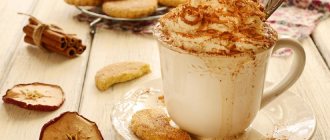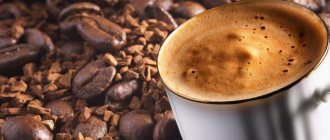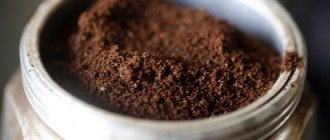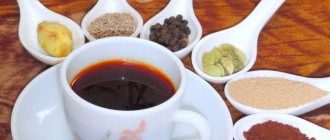Copper utensils have been known for a very long time, and even in many historical excavations, the first kitchen utensils were made of copper. There is a lot of talk around her. They say that it is quite harmful. Although there are people who say that all these ideas about harm are simply nothing more than exaggerated, incorrect facts.
Set of copper utensils.
Copper in the kitchen
Copper dishes look very attractive. That is why she is the guest of honor in the kitchen. Spoons, bowls for making desserts and jam, and most importantly, for coffee lovers - a Turk. These are all essential attributes of any kitchen. The metal is believed to have antibacterial properties, some of which have already been proven by scientists. It can remove various fungi and bacteria from water and other products. There are even confirmed facts that it removes E. coli and salmonellosis. Therefore, the appearance of copper utensils in the kitchen is not such a surprising fact.
The benefits of dishes
Of the beneficial properties, it is worth noting not only visual beauty. There are other advantages. Thus, copper cookware is very thermally conductive. That is why it is indispensable for preparing various sauces, jams and seafood. Due to the fact that heating occurs evenly and very quickly, a large number of beneficial properties of different products are preserved. It is believed that microparticles get into various products and give them a certain, unusual taste.
This metal is a good antibacterial agent. It is known that in ancient times they even specially stored water in such pans in order to disinfect it.
Copper itself is quite light, especially when it comes to special alloys, such as brass. These properties are complemented by many others. At the same time, it remains strong and durable so much that it can even be passed on from generation to generation.
Negative qualities
It is worth mentioning that this metal has several negative properties. For example, some fruit acids, upon contact with a copper surface, oxidize and release harmful substances to the body, which can even lead to poisoning. After cooking, you need to remove food from copper containers to avoid oversaturation with these elements.
Excess moisture may cause copper to develop a patina. This is a greenish coating that is released upon contact with abundant moisture. You absolutely cannot cook in dishes with such defects. They do not appear on brass products.
A large amount of copper in the body is fraught with nutritional disorders. Children, as well as those with liver problems, should not eat from dishes made from such material, because they are very susceptible to the influence of excess copper.
Another important disadvantage is the rather high cost of the dishes. But you need to think about the fact that for the big money that kitchen utensils cost, you can leave an inheritance even to a generation of grandchildren.
Benefit or harm?
Let’s say right away that copper cookware requires a special approach. It is recommended to cook, first of all, sweet dishes with a high sugar content in copper cookware - in this case it will not oxidize. It must be washed thoroughly and cannot be used for storing prepared foods. It is better to use wooden spoons and spatulas for mixing here, and wash dishes in soapy water, avoiding aggressive chemicals. Also, do not use abrasives or metal sponges.
But rumors about the dangers of copper in everyday life are greatly exaggerated. Suffice it to remember that for several centuries we have been using copper pipes from which water flows into our homes. Up to 100 g of copper is contained in the body of each person, and the optimal dose of copper that we should receive daily is up to 2 mg. It is almost impossible to exceed this concentration even with daily use of copper cookware. This trace element takes part in natural metabolism. Therefore, it does not accumulate, but is excreted from the body along with other waste products.
Moreover: it has been proven that copper, like silver, has an antiseptic effect. Even before the invention of antiseptics, it was used to disinfect and prevent infections - for example, during the plague epidemic. In 2008, the bactericidal properties of copper were officially recognized - based on the results of studies conducted by the American Environmental Protection Agency.
The conclusion is obvious: for humans, copper in everyday life is more necessary than harmful. Consequently, copper utensils, provided they are a high-quality product, are an extremely useful item in the household.
Types of copper utensils
Copper itself is a rather soft and expensive metal, so kitchen utensils made from pure copper are very expensive and not of very high quality. Various compositions are often created that help preserve the properties of copper, but at the same time improve them as much as possible. The most common are a mixture of copper and zinc called brass; copper and nickel, which is cupronickel, and nickel silver is a mixture of copper, zinc and nickel.
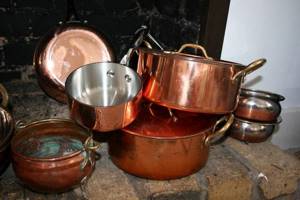
Utensils made of copper.
Among the large number of copper kitchen utensils, the most practical are:
- pots, which can be of different volumes and depths;
- frying pans with handles or high sides;
- thick-bottomed saucepans;
- teapots;
- samovars;
- Turks;
- gravy boats;
- buckets;
- sugar bowls;
- candy bowls;
- cutlery.
Trays of different types, thicknesses and shapes are perfect for serving. All these samples of kitchen utensils can be made of brass.
Inner coating
Copper cookware oxidizes very quickly, so it must be chosen so that there is a coating of another metal inside. Most often it is stainless steel or tin. The stainless steel must be dense inside, and on the outside the copper layer retains all its useful and thermally conductive properties.
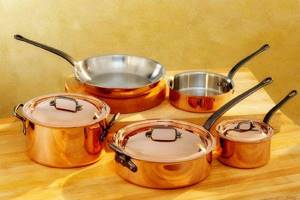
Cookware with inner coating.
Copper utensils are often coated with tin, the so-called tinned copper. Because of this, a rather dense layer is obtained, which helps to improve all the properties of this noble metal. Chefs often use just such dishes, because they are very easy to restore by repeating the tinning procedure.
Without inner covering
If you buy copper cookware without an internal coating, you need to understand that many unscrupulous sellers can pass off a mixture of another metal with a thin layer of copper plating as the original. Copper cookware is quite heavy, uniform and looks very expensive. Often, imitation stainless steel is sold under the guise of uncoated copper.
In its pure form, copper utensils can only be used for preparing cold dishes, boiling clean water and creating desserts, such as jam, which will then be placed in another container.
What is allowed and prohibited to do with it
Provided that copper cookware is coated with a protective layer, it can be used to cook almost any dish. However, for the most part, it is designed for cooking over low heat, without sudden temperature changes, by stewing, evaporating or simmering. Also suitable for quick cooking, which helps preserve the taste and nutritional properties of food.
Kitchen utensils made of pure copper, without an internal layer of protection, are mainly suitable for preparing cold dishes without acidic ingredients. Such utensils are ideal for kneading and baking baked goods, making desserts with sugar, egg yolks, caramel and chocolate. It is possible to boil water, cook broths, brew coffee, tea, stew meat and fish dishes, cook porridge and pilaf. Food with acidic contents will damage the dishes.

It is better not to use uncoated cookware for cooking on the stove.

Cookware with an inner coating can be used for preparing any food
Secrets of choosing copper cookware
In order to use this metal correctly, many chefs share their secrets of choice. You need to understand that even the highest cost product will undoubtedly justify itself, because copper cookware is an extremely long-term investment. Copper utensils are always sold without lids, and you can hardly buy them from Russian manufacturers.
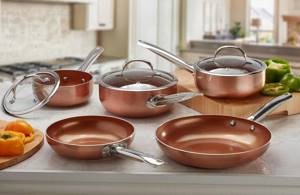
Set of pots and pans made of copper.
It is better to choose forged copper cookware; it will last much longer. Available in tin, steel or nickel plating. But you should understand that these containers are more suitable for quick cooking or boiling.
How to choose copper cookware?
Before you go shopping for copper cookware, you should know that not only its appearance and price should be attractive. There are a few more important points that will help you make the perfect purchase:
- To ensure that your pot or pan lasts as long as possible, give preference to forged or hammered products.
- Remember that copper is heavier than steel and aluminum, so dishes made from this metal a priori cannot be light. Handmade dishes, which originate from Iran or India, are considered to be of the highest quality.
When choosing copper utensils, pay attention to its internal coating:
- Nickel and steel are ideal choices for frying pans - they are better suited for frying.
- If you will only cook food, then give preference to tin. It can withstand high temperatures, but at the same time, it costs less.
Important! To determine if the tin coating has reached its end of life, apply a strong detergent to a small area of the pan. If copper is visible, it means it’s time to buy new cookware.
- Egg whites become thicker when they come into contact with copper. Therefore, almost all desserts are prepared in copper dishes without coating, since sweets do not oxidize the surface, and there is no exposure to high temperatures. For example, a chic Italian dessert - egg cream with sugar and wine - will not work in any other bowl except copper.
- Professional frying pans and saucepans are traditionally sold without lids. But if you need it, then for copper choose flat caps with the smallest diameter. This coating will last longer since it only occasionally comes into contact with food.
Important! Do not purchase copper cookware online or from a catalogue. The decision to purchase it must be made on the spot, at the counter, when you have the opportunity to look at it, touch it and try how comfortable it is in your hand. For some, such utensils seem too heavy and will be unusual to use. However, most cooks get used to this very quickly, and the result more than compensates for this shortcoming.
Using copper utensils correctly
There are a number of important conditions that must be observed in order not to cause harm. The prepared dish in copper dishes is more tasty, but it must be taken into account that food cannot be stored in it for a long time. This is especially true for sour foods or those that contain acid, and even fruits.
Empty dishes without contents should not be left on the fire to avoid cracks. Copper likes a good cleaning, but does not tolerate abrasives or heavy scratches. Therefore, you need to use silicone or wooden spatulas for cooking.
Harm and danger of copper cookware
Unfortunately, products made from copper are not ideal. They have several disadvantages and some of them are very significant:
- The metal reacts chemically with some products. Substances formed during such processes can have a negative effect on the human body. This will not happen if you do not allow copper utensils to come into contact with acidic foods or dishes. Despite the fact that today manufacturers are increasingly coating utensils with a special non-oxidizing coating, you should not conduct dubious experiments with copper utensils.
- The metal itself is not cheap, so you should not count on buying products at a low price. And to purchase a whole set you will have to pay a significant amount. If copper cookware is sold at a large discount or is initially inexpensive, it is most likely not of high quality or is a fake.
- The increased sensitivity of the metal to external influences can cause a lot of trouble. Household items made of copper are easily scratched and deformed, so you need to care for them carefully and very carefully.
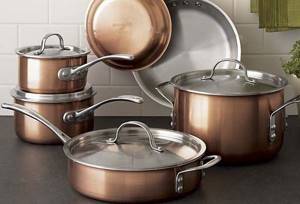
You also need to remember that improper care of products can cause the formation of patina on copper. Contact of this formation with food will not add beneficial properties to the latter and will negatively affect its taste.
Symptoms of copper poisoning
Copper is a normal component that is important for the development of the body, but only a small amount is needed. Usually people get it from various products, but in case of excess, which occurs due to the ingestion of large amounts of copper salts, there can be serious consequences, including poisoning.
The first symptoms are a sharp drop in blood pressure, weakness, diarrhea, abdominal pain, as well as a metallic taste and vomiting. In very advanced situations of poisoning, there may even be breathing problems and convulsions. Very often these symptoms are similar to liver diseases, which is primarily affected by copper.

Weakness and fatigue are the first signs of copper poisoning.
Selection of Turks by material
Traditionally, Turks were made from copper sheets. For this reason, when choosing a specific product, a comparison is usually made with copper, that is, they compare which pot is better to brew coffee in, copper or ceramic, copper or brass, etc. This is quite logical, and most importantly, such differences and similarities are clear to most coffee lovers, since many people have copper cezves; this is the most common option. But for those who choose their first cezve, we will look at the characteristics of a copper coffee maker in more detail.
Copper Turk
Copper cezves are the best choice for most coffee lovers. Thick walls and high thermal conductivity of copper provide uniform heating and allow you to control the cooking process to get a truly perfect taste. As a rule, the bottom is almost twice as wide as the neck, due to which a foamy cap is formed, under which all the coffee components are preserved, so the drink turns out aromatic and with a rich taste.
In a copper container at home, you can extract coffee efficiently without bringing it to a boil, thereby preventing the appearance of excessive bitterness and preserving the taste and smell.
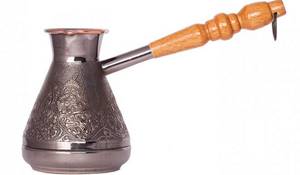
Important: since copper itself oxidizes, it is coated on the inside with a layer of metal, most often edible tin. It is advisable not to use chemicals and, especially, hard washcloths for washing, so as not to damage this layer.
Ceramic Turk
Ceramics is the second most popular material for making Turks, and most often the choice for a home is made between ceramics and copper. The only correct answer to the question of which pot is better to brew coffee in, copper or ceramic, cannot be given: each option has its own characteristics.
The ceramic container also heats the water evenly, extracting the best flavor and aroma components of the coffee, and the foam head is velvety and high. But at the same time, the walls retain heat longer, and the cooking process continues when you remove it from the stove, so you need not to overheat the drink, so that it does not become bitter, does not become too strong, and, in the end, simply does not run away, as the cooking continues.
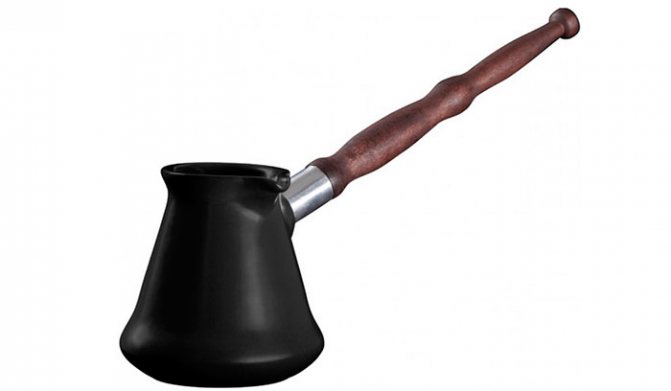
The only significant disadvantage of a ceramic Turk compared to a copper one is the fragility of the material.
Brass Turk
Brass is another material that copper is often compared to. In a copper or brass pot, the drink is prepared in a similar way, since brass is an alloy of copper, only cheaper and more convenient, it does not oxidize so much. It is very difficult to find a product made of pure copper; most often it is brass. But an interior lining of food-grade tin or stainless steel is still required, so the washing principles are the same.
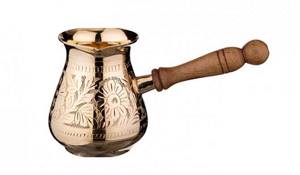
What is called a copper cezve in many stores is in fact usually brass.
Clay Turk
Cezves made of clay are not found very often, since the material is very unique. But it also has its fans, who, when asked which pot to brew coffee in, clay or metal, will confidently choose clay. Clay is a living material, it is porous, and absorbs oils specific to each type of grain. It is believed that only one type of grain can be brewed in a clay container, at least for true gourmets and connoisseurs this is so.

You should be careful with clay coffee makers at home: they can even be damaged by temperature changes during washing. And, of course, you shouldn’t scratch them from the inside with anything or wash them with detergent, since it will also be absorbed into the walls.
Stainless steel pot
Stainless steel is an excellent material for those who like to experiment with varieties and flavors of coffee at home. Absolutely does not absorb any oils, it is easy to wash clean from dark deposits. But - such a cezve is not very suitable for gourmets - the metal heats up unevenly, near the bottom the water boils faster, which can lead to overheating of the coffee and, accordingly, bitterness. Between a Turkish pot made of copper and stainless steel, it is still better to choose copper, but look at the situation and preferences.

Universal ladles are often made from stainless steel; their neck is usually very wide, often like a bottom, so it is difficult to brew a really high-quality drink in this vessel. But it does not break and can serve for decades without losing its appearance.
Turk made of aluminum
Today, aluminum cezves are practically not produced, but until recently, consumers thought quite seriously about which Turk produces better coffee: copper or aluminum. The fact is that aluminum is much cheaper, and this often influenced the choice of the first cezve - you have to start somewhere. On the other hand, such a thing does not look very elegant, and aluminum is also capable of reacting when heated, so it is not very useful. But this is a good option for making coffee outdoors, in camping conditions.
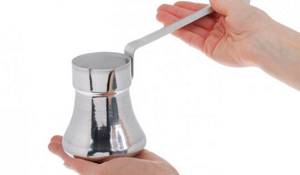
With the choice that we have now, aluminum products are not the best choice, and we recommend any other option.
Glass Turk
Glass Turks appeared on the market relatively recently, but many people like them. For their manufacture, special thermal glass is used, so that the container can be placed on fire. The main thing is to look for a model with a narrower neck, since the wider it is, the less foam there will be, and the less taste and aroma will be preserved. On the other hand, a glass container can be used as a universal ladle for heating milk, cocoa, and hot chocolate. True coffee lovers confidently choose a metal one between a glass and a copper pot for their home, but if the nuances of taste do not interest you, you can also buy glass.
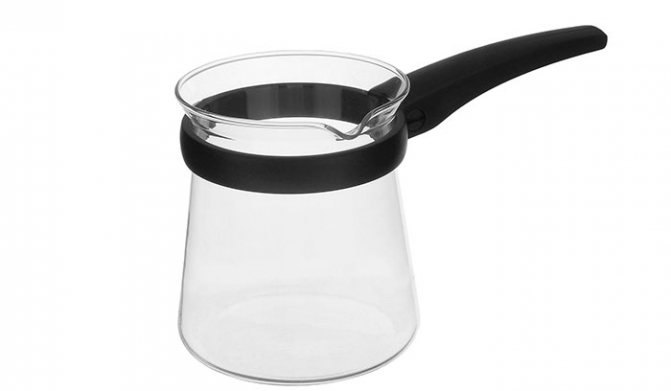
An important disadvantage: water boils quite quickly in glass, so there is a chance to boil coffee, but still not achieve perfect extraction.
A few words about the manufacturers
Once again it is worth noting the fact that the cost of the product is quite high. Russian, Ukrainian and Belarusian manufacturers do not produce such elements on a mass scale. This doesn't justify itself at all.
But there are several famous European companies that create good copper cookware. These are the Portuguese Bioflon, the Italian Ruffoni, the French Mauviel and De Buyer, as well as the Italian manufacturer TVS.
It is necessary to understand that even despite the high cost, this dish will justify the expense, because it will live for more than one day and will be inherited by more children and grandchildren.
Care and cleaning
It is necessary to take care of copper utensils so that their bright appearance does not suffer and remains that way for as long as possible. There are several ways to properly care for it:
- No ordinary cleaning products, chlorine powders or hard sponges should be used, because they will scratch the delicate coating.
- You need to know that copper cannot be left wet at all; a green coating immediately appears on it, which is harmful.
To clean copper surfaces, it is best to use lemon, citric acid, vinegar, salt or soda. To clean copper, you need to cut the lemon into slices and rub the dishes well, then rinse under running water. This product helps clean almost any copper utensil.
By analogy, vinegar and soda are used. Very often, cleaning dishes in a citric acid solution helps restore the dishes to their original appearance. It is worth understanding that any mechanical damage causes irreparable harm to the coating.
Caring for Copper Cookware
The shiny appearance of new copper cookware lasts only until the first cooking. Pots and pans used in the kitchen require constant and special care:
- During the cooking process, you should not keep the dishes on the fire empty.
- You should also not pour boiling water into a dry pan.
- Food that is cooked in copper cookware can only be stirred with a special wooden spoon or spatula, also to avoid scratches.
- It is better to add salt only after the liquid has boiled. Experienced housewives notice that this also allows you to keep copper utensils in good condition for as long as possible.
- Copper utensils can only be washed by hand; do not use household appliances to clean them.
- The use of cleaning products is also not recommended. They can damage the internal coating. Replace household chemicals with special cleaners or make a homemade paste from flour and fine salt.
- The use of hard metal scourers, brushes or nets is also prohibited. They scratch the surface, break the protective layer, and the copper enters into an unwanted chemical reaction with food, making the dishes harmful to health.
- Some stains on copper cookware can be removed with freshly squeezed lemon juice mixed with fine salt. Cleaning copper with tomato paste is also effective.
- Some time after use, you can treat copper cookware with a special polishing compound that will return the original shine to your pots and pans.

